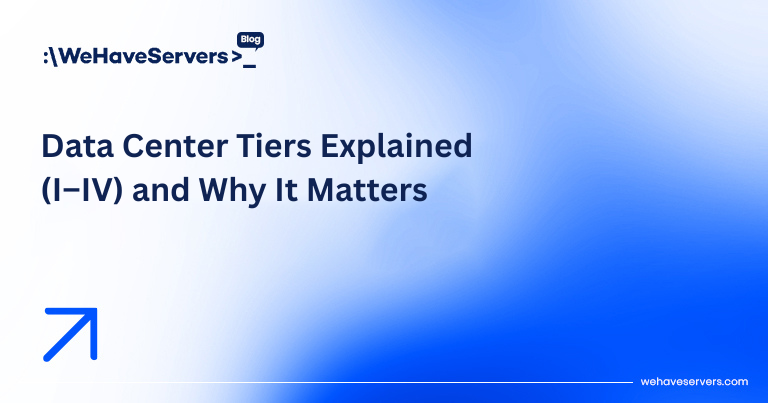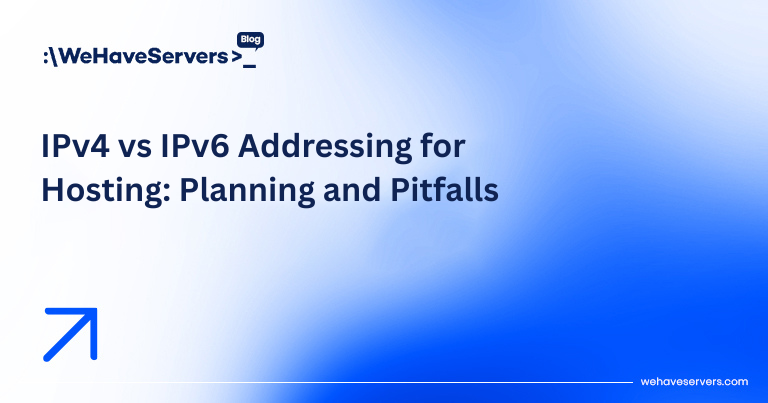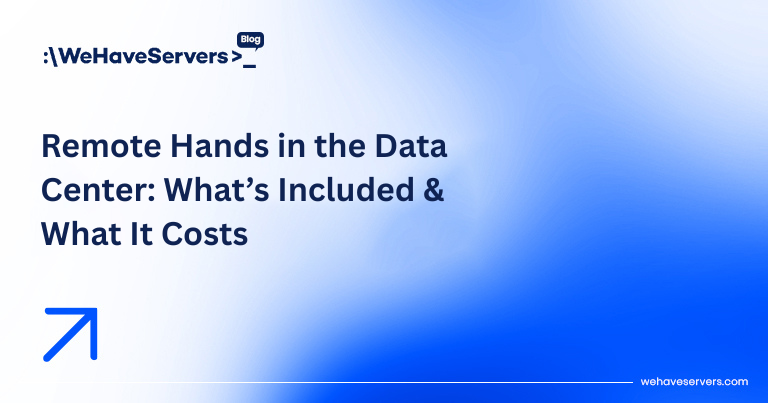
Data Center Tiers Explained (I–IV) and Why It Matters
Data Center Tiers Explained (I–IV) and Why It Matters
When selecting a colocation facility, cloud region, or dedicated hosting provider, one of the most important — yet often misunderstood — standards is the Data Center Tier classification. Defined by the Uptime Institute, these tiers (I through IV) measure a facility’s redundancy, resilience, and availability. In 2025, with workloads becoming increasingly mission-critical, understanding data center tiers is essential for CTOs, sysadmins, and enterprise architects.
This article provides a detailed breakdown of Tier I, II, III, and IV data centers, their design requirements, expected uptime, and the business cases where each makes sense. We’ll also cover real-world costs, compliance implications, and why tiers directly affect your SLA.
🔹 The Uptime Institute Tier Standard
The Uptime Institute introduced the Tier Classification System in the 1990s to provide a vendor-neutral way to evaluate data centers. Unlike marketing claims (“carrier-neutral,” “enterprise-ready”), tiers are based on measurable redundancy and fault tolerance.
- Tier I: Basic capacity.
- Tier II: Redundant capacity components.
- Tier III: Concurrent maintainability.
- Tier IV: Fault tolerance.
Certification is awarded after rigorous design and constructed-facility audits. Many providers self-advertise tiers without certification — always verify with Uptime Institute’s registry.
🔹 Tier I – Basic Capacity
- Redundancy: N (no redundancy).
- Expected Uptime: 99.671% (~28.8 hours downtime/year).
- Design: Single power and cooling path. No backup generators required.
Tier I data centers are essentially professional server rooms. They provide conditioned power and cooling, but any component failure or scheduled maintenance causes downtime.
Use Case: Small businesses, startups, non-critical applications where downtime is tolerable.
🔹 Tier II – Redundant Capacity
- Redundancy: N+1 (redundant power and cooling components).
- Expected Uptime: 99.741% (~22 hours downtime/year).
- Design: Some redundancy for UPS, cooling, and generators. Still a single distribution path.
Tier II adds resilience against component failures but remains vulnerable to path interruptions (e.g., single utility feed, single switchgear).
Use Case: SMBs hosting e-commerce or SaaS platforms where downtime must be reduced but budgets remain tight.
🔹 Tier III – Concurrently Maintainable
- Redundancy: N+1, with dual power/cooling paths.
- Expected Uptime: 99.982% (~1.6 hours downtime/year).
- Design: All critical systems are redundant, and any component can be maintained without shutting down IT load.
Tier III facilities support 24/7 uptime with planned maintenance. Dual power feeds (A+B), multiple UPS strings, and redundant chillers ensure no single point of failure.
Use Case: Enterprises, financial services, SaaS providers with strict SLAs. Most colocation providers in Europe advertise Tier III compliance.
🔹 Tier IV – Fault Tolerant
- Redundancy: 2N or 2N+1 (fully fault tolerant).
- Expected Uptime: 99.995% (~26 minutes downtime/year).
- Design: Independent, physically isolated systems for power and cooling. Survives multiple failures without impact.
Tier IV is the gold standard. Facilities are designed for mission-critical workloads — think stock exchanges, medical systems, government defense. Costs are substantially higher, but so is resilience.
Use Case: Enterprises with zero downtime tolerance, regulated industries, hyperscale cloud operators.
🔹 Uptime & SLA Comparison
| Tier | Redundancy | Expected Uptime | Downtime/Year |
|---|---|---|---|
| I | N | 99.671% | 28.8 hours |
| II | N+1 | 99.741% | 22 hours |
| III | N+1 | 99.982% | 1.6 hours |
| IV | 2N or 2N+1 | 99.995% | 26 minutes |
Notice the leap from Tier II to Tier III — downtime drops from 22 hours to under 2 hours per year. For most businesses, Tier III strikes the best cost-availability balance.
🔹 Cost Considerations
Building/operating higher-tier facilities is expensive:
- Tier I: €300–€600 per kW/month.
- Tier II: €500–€800 per kW/month.
- Tier III: €800–€1500 per kW/month.
- Tier IV: €1200–€2500 per kW/month.
Colocation clients pay higher rack rates in Tier III/IV facilities, but the SLA-backed uptime justifies the premium for critical workloads.
🔹 Compliance & Certification
- GDPR: Requires data protection, but Tier III+ provides infrastructure to enforce it.
- PCI DSS: Payment processors often require Tier III or above.
- HIPAA: Healthcare workloads benefit from Tier III/IV resilience.
Certification matters: many providers advertise “built to Tier III standards” without actual Uptime Institute certification. Always verify.
🔹 Real-World Examples
1. Startup in a Tier I Facility
- Lower costs, but suffered outages during power maintenance.
- Eventually migrated to Tier III as customer SLAs tightened.
2. Regional Bank in Tier III
- Concurrent maintainability allowed upgrades with zero downtime.
- Met compliance for financial regulators.
3. Hyperscaler in Tier IV
- Runs mission-critical workloads across multiple continents.
- Fault tolerance allows operations even during multiple failures.
✅ Conclusion
Data center tiers directly impact your uptime, compliance, and costs. Tier I/II may suffice for non-critical apps, but Tier III is the global standard for enterprise workloads. Tier IV is reserved for the highest-risk industries. When negotiating colocation or cloud contracts, always ask: “Is the facility Uptime-certified, and what Tier is guaranteed in the SLA?”
At WeHaveServers.com, our Romanian/EU colocation facilities are built to Tier III+ standards, combining redundant power, cooling, and carrier-neutral connectivity to ensure near-constant uptime for our clients.
❓ FAQ
What is the difference between Tier III and Tier IV?
Tier III allows concurrent maintainability, while Tier IV provides full fault tolerance with independent systems.
Do all Tier III facilities guarantee certification?
No. Many claim “built to Tier III standard” but lack Uptime Institute certification. Always verify.
Is Tier I acceptable for production?
Yes, for non-critical apps. But expect ~29 hours of downtime per year.
Why do costs rise so sharply with higher tiers?
Additional redundancy requires duplicate systems: dual UPS, dual chillers, dual generators, etc.
Which tier should I choose?
For most businesses: Tier III. For mission-critical or regulated workloads: Tier IV.



